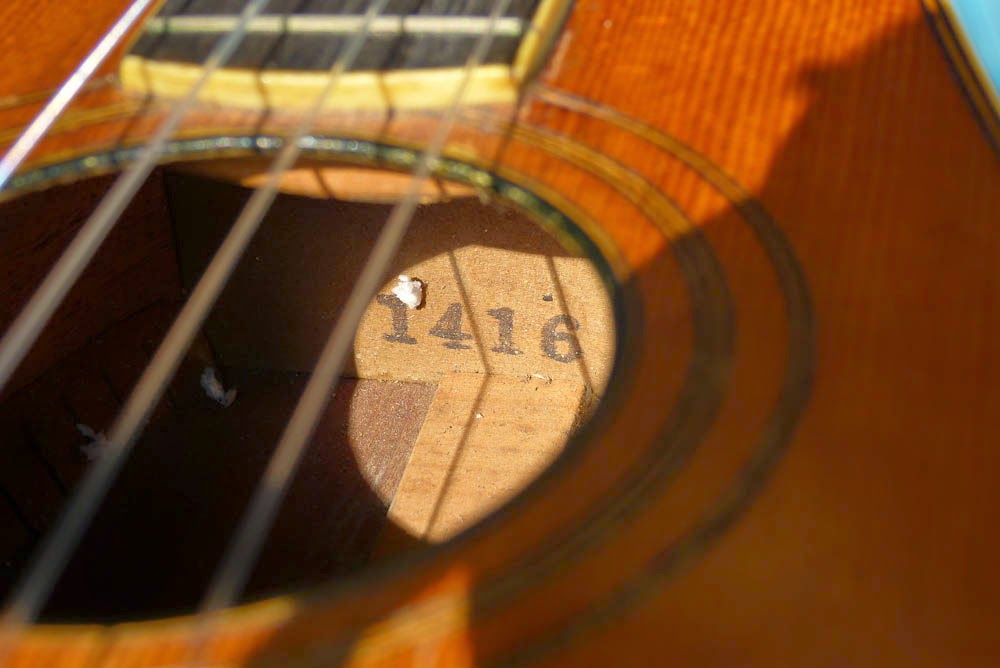c.1925 Washburn Style 5265 Tenor Guitar/Baritone Uke Conversion
Update 2016: This came back in for trade and it'd been strung-up GDAE (octave mandolin) with nylon for 2+ years. I restrung it with all-plain, re-entrant uke strings for dGBE tuning which you can hear in the above soundclip. The original clip (below) is for low-D tuning using classical guitar strings. I've also added 4:1 geared tuners and added some new pictures where necessary.
Oh man, another fun tenor guitar, huh? It's a L&H-made/sold Washburn brand instrument (I think these were Regal-made) like this L&H American Conservatory one... but this one has a surprise... it's been converted to a baritone uke! Upon receiving this tenor I noted that the neck was just absolutely cut too thin for steel strings. It had a set of steel on it and even at 3/4 tension it showed warp. Conversion to nylon/baritone uke was thus necessary... and guess what? That neck is stable and flat... and it sounds loud, proud, and cool.
Some work had been done to this before: multiple hairline crack fills/repairs, replaced frets, and a top coat of varnish applied. My work "finished" some of this work including cleating some of the hairline cracks, leveling/dressing the frets, removing the last bits of mucked-up pearl work, installing new pearl dots, a uke-style glued-on bridge, new bone nut, crack repair at the headstock (as well as some dowels installed to support them), and setup. This has a 22 3/4" scale length and I didn't have a set of baritone uke strings on hand but the DGBE strings from a set of D'Addario classical guitar strings worked just fine on it.
Update: this is currently wearing a set of D'Addario "Titanium" soprano uke strings which are gauged almost the same as D'Addario classical guitar (normal tension) DGBE strings save that the first is re-entrant and plain. As mentioned, I've also replaced the tuners with geared 4:1 Grover units and re-used the original buttons. Take a look:
Update: this is currently wearing a set of D'Addario "Titanium" soprano uke strings which are gauged almost the same as D'Addario classical guitar (normal tension) DGBE strings save that the first is re-entrant and plain. As mentioned, I've also replaced the tuners with geared 4:1 Grover units and re-used the original buttons. Take a look:
Now back to the original post and pictures...
I love this body shape especially with its peculiar "pear" profile. It sits beautifully in the lap and compared to some other tenor guitar shapes/baritone uke shapes it has the bridge in "the sweet spot" at the widest part of the soundboard. You get a lot more volume this way. The original light ladder bracing is also conducive to the baritone-uke conversion of this instrument... it's responsive.
New bone nut! This has a 1 1/8" nut and a thin front/back C-shape profile which makes it feel a lot like a modern baritone or tenor uke. It's great for playing closed-position chords up the neck.
I approximated the old lost inlay with 2 white pearl + 1 abalone dot inlays instead. It looks pretty classy from the audience's perspective. The board is dyed maple and bound in ivoroid celluloid.
I love the 3-ring rosette and cream/black purfling/binding.
This is an old 1930s Harmony uke bridge and it worked perfectly for gluing to this tenor/bari. There are several (cleated) long top hairline cracks on this instrument.
I think I forgot to mention materials: it's a solid spruce top with solid mahogany back/sides and a Spanish cedar neck.
There are, of course, multiple long hairline cracks on the back that have previously been worked on/mucked up a bit... but they're stable.
The cracks are glued up... but I also reinforced this precarious section with a couple dowels, too.
Update: the cracks are all holding pat 2+ years on. See earlier in the post for the newer 4:1 geared Grover tuners I installed (re-using the original buttons). They're a huge practicality improvement.
Update: the cracks are all holding pat 2+ years on. See earlier in the post for the newer 4:1 geared Grover tuners I installed (re-using the original buttons). They're a huge practicality improvement.
The neck is perfectly set.
The serial dates it to around 1925.






































Comments